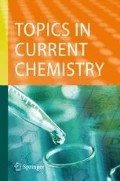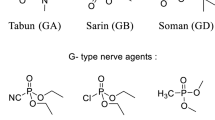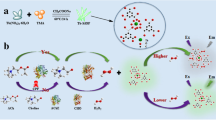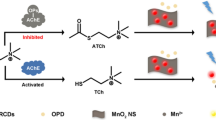Abstract
Organophosphorus (OP) compounds are typically a broad class of compounds that possess various uses such as insecticides, pesticides, etc. One of the most evil utilizations of these compounds is as chemical warfare agents, which pose a greater threat than biological weapons because of their ease of access. OP compounds are highly toxic compounds that cause irreversible inhibition of enzyme acetylcholinesterase, which is essential for hydrolysis of neurotransmitter acetylcholine, leading to series of neurological disorders and even death. Due to the extensive use of these organophosphorus compounds in agriculture, there is an increase in the environmental burden of these toxic chemicals, with severe environmental consequences. Hence, the rapid and sensitive, selective, real-time detection of OP compounds is very much required in terms of environmental protection, health, and survival. Several techniques have been developed over a few decades to easily detect them, but still, numerous challenges and problems remain to be solved. Major advancement has been observed in the development of sensors using the spectroscopic technique over recent years because of the advantages offered over other techniques, which we focus on in the presented review.
Graphic Abstract











































Similar content being viewed by others
References
Marrs TC (1993) Organophosphate poisoning. Pharmacol Therap 58(1):51–66
Thakur A, Patil P, Sharma A, Flora SJS (2020) Advances in the development of reactivators for the treatment of organophosphorus inhibited cholinesterase. Curr Org Chem 24(24):2845–2864. https://doi.org/10.2174/1385272824999201020203544
Sidell F, Borak J (1992) Chapter chemical warfare agents introduction decontamination. Ann Emerg Med 21:611–625
Wadia RS, Sadagopan C, Amin RB (1974) Neurological manifestations of organophosphorous insecticide poisoning. J Neurol Neurosurg Psychiatry 37:841–847
Czajka M, Matysiak-Kucharek M, Jodłowska-Jędrych B, Sawicki K, Fal B, Drop B, Kruszewski M, Kapka-Skrzypczak L (2019) Organophosphorus pesticides can influence the development of obesity and type 2 diabetes with concomitant metabolic changes. Environ Res 178:108685. https://doi.org/10.1016/j.envres.2019.108685
Jokanovi M (2009) Medical treatment of acute poisoning with organophosphorus and carbamate pesticides. Toxicol Lett 190:107–115. https://doi.org/10.1016/j.toxlet.2009.07.025
Tougu V (2005) Acetylcholinesterase: mechanism of catalysis and inhibition. Curr Med Chem Nerv Syst Agents 1:155–170. https://doi.org/10.2174/1568015013358536
Silman I, Sussman JL (2005) Acetylcholinesterase: “classical” and “non-classical” functions and pharmacology. Curr Opin Pharmacol 5:293–302. https://doi.org/10.1016/j.coph.2005.01.014
Chauhan S, Chauhan S, D’Cruz R, Faruqi S, Singh KK, Varma S, Singh M, Karthik V (2008) Chemical warfare agents. Environ Toxicol Pharmacol 26:113–122. https://doi.org/10.1016/j.etap.2008.03.003
Soltaninejad K, Shadnia S (2014) History of the use and epidemiology of organophosphorus poisoning. Springer, pp 25–43. https://doi.org/10.1007/978-1-4471-5625-3
Costanzi S, Machado JH, Mitchell M (2018) Nerve agents: what they are, how they work, how to counter them. ACS Chem Neurosci 9:873–885. https://doi.org/10.1021/acschemneuro.8b00148
Koblentz GD (2019) Chemical-weapon use in Syria: atrocities, attribution, and accountability. Nonprolif Rev 26:575–598. https://doi.org/10.1080/10736700.2019.1718336
Shih TM, Kan RK, McDonough JH (2005) In vivo cholinesterase inhibitory specificity of organophosphorus nerve agents. Chem Biol Interact 157–158:293–303. https://doi.org/10.1016/j.cbi.2005.10.042
Kenyon IR, Gutschmidt K, Cosivi O (2005) Legal aspects and international assistance related to the deliberate use of chemicals to cause harm. Toxicology 214:249–255. https://doi.org/10.1016/j.tox.2005.06.017
Haines DD, Fox SC (2014) Acute and long-term impact of chemical weapons: lessons from the Iran-Iraq War. Forensic Sci Rev 26(2):97–114
Profile C (1997) Definitive evidence for the acute sarin poisoning diagnosis in the Tokyo subway. Toxicol Appl Pharmacol 203:198–203
Rosman Y, Eisenkraft A, Milk N, Shiyovich A, Ophir N, Shrot S, Kreiss Y, Kassirer M (2014) Lessons learned from the Syrian sarin attack: evaluation of a clinical syndrome through social media. Ann Intern Med 160(9):644–648
Kim K, Tsay OG, Atwood DA, Churchill DG (2011) Destruction and detection of chemical warfare agents. Chem Rev 111:5345–5403. https://doi.org/10.1021/cr100193y
Li X, Cui H, Zeng Z (2018) A simple colorimetric and fluorescent sensor to detect organophosphate pesticides based on adenosine triphosphate-modified gold nanoparticles. Sensors 18(12), 4302 (Switzerland). https://doi.org/10.3390/s18124302
Déjous C, Rebière D, Pistré J, Tiret C, Planade R (1995) A surface acoustic wave gas sensor: detection of organophosphorus compounds. Sens Actuators B Chem 24:58–61. https://doi.org/10.1016/0925-4005(95)85012-0
Orbulescu J, Constantine CA, Rastogi VK, Shah SS, Defrank JJ, Leblanc RM (2006) Detection of organophosphorus compounds by covalently immobilized organophosphorus hydrolase. Anal Chem 78:7016–7021
Marx S, Zaltsman A (2003) Molecular imprinting of sol gel polymers for the detection of paraoxon in water. Int J Environ Anal Chem 83:671–680. https://doi.org/10.1080/0306731021000015029
Hou X, Zheng X, Zhang C, Ma X (2014) Ultrasound-assisted dispersive liquid–liquid microextraction based on the solidification of a floating organic droplet followed by gas chromatography for the determination of eight pyrethroid pesticides in tea samples. J Chromatogr B 969:123–127. https://doi.org/10.1016/j.jchromb.2014.08.010
Jafari MT, Saraji M, Sherafatmand H (2014) Polypyrrole/montmorillonite nanocomposite as a new solid phase microextraction fiber combined with gas chromatography—corona discharge ion mobility spectrometry for the simultaneous determination of diazinon and fenthion organophosphorus pesticide. Anal Chim Acta 814:69–78. https://doi.org/10.1016/j.aca.2014.01.037
Zhao X, Kong W, Wei J, Yang M (2014) Gas chromatography with flame photometric detection of 31 organophosphorus pesticide residues in Alpinia oxyphylla dried fruits. Food Chem 162:270–276. https://doi.org/10.1016/j.foodchem.2014.04.060
Black RM, Clarke RJ, Read RW, Reid MTJ (1994) Application of gas chromatography-mass spectrometry and gas chromatography-tandem mass spectrometry to the analysis of chemical warfare samples, found to contain residues of the nerve agent sarin, sulphur mustard and their degradation products. J Chromatogr A 662:301–321. https://doi.org/10.1016/0021-9673(94)80518-0
Rodrigues ET, Pardal MÂ, Salgueiro-González N, Muniategui-Lorenzo S, Alpendurada MF (2016) A single-step pesticide extraction and clean-up multi-residue analytical method by selective pressurized liquid extraction followed by on-line solid phase extraction and ultra-high-performance liquid chromatography-tandem mass spectrometry for complex matrices. J Chromatogr A. https://doi.org/10.1016/j.chroma.2016.05.036
Synaridou MS, Sakkas VA, Stalikas CD, Albanis TA (2014) Evaluation of magnetic nanoparticles to serve as solid-phase extraction sorbents for the determination of endocrine disruptors in milk samples by gas chromatography mass spectrometry. J Chromatogr A. https://doi.org/10.1016/j.chroma.2014.04.092
Zhong Q, Shen L, Liu J, Yu D, Li S, Yao J, Zhan S, Huang T, Hashi Y, Kawano S, Liu Z, Zhou T (2016) Pre-column dilution large volume injection performance liquid chromatography-tandem mass spectrometry for the analysis of multi-class pesticides in cabbages. J Chromatogr A 1442:53–61. https://doi.org/10.1016/j.chroma.2016.03.010
Giordano B, Collins G (2007) Synthetic methods applied to the detection of chemical warfare nerve agents. Curr Org Chem 11:255–265. https://doi.org/10.2174/138527207779940883
Liu T, Cao P, Geng J, Li J, Wang M (2013) Determination of triazine herbicides in milk by cloud point extraction and high-performance liquid chromatography. Food Chem. https://doi.org/10.1016/j.foodchem.2013.07.062
Watanabe E, Baba K (2015) Highly sensitive quantification of pyrethroid insecticide etofenprox in vegetables with high-performance liquid chromatography and fluorescence detection. J Chromatogr A 1385:35–41. https://doi.org/10.1016/j.chroma.2015.01.056
Yang M, Xi X, Wu X, Lu R, Zhou W, Zhang S, Gao H (2015) Vortex-assisted magnetic β-cyclodextrin/attapulgite-linked ionic liquid dispersive liquid–liquid microextraction coupled with high-performance liquid chromatography for the fast determination of four fungicides in water samples. J Chromatogr A. https://doi.org/10.1016/j.chroma.2015.01.016
Wu D, Sedgwick AC, Gunnlaugsson T, Akkaya EU, Yoon J, James TD (2017) Fluorescent chemosensors: the past, present and future. Chem Soc Rev 46:7105–7123. https://doi.org/10.1039/c7cs00240h
Coto PB, Serrano-Andrés L, Gustavsson T, Fujiwara T, Lim EC (2011) Intramolecular charge transfer and dual fluorescence of 4-(dimethylamino) benzonitrile: ultrafast branching followed by a two-fold decay mechanism. Phys Chem Chem Phys 13(33):15182–15188. https://doi.org/10.1039/C1CP21089K
Kavarnos GJ (1990) Fundamental concepts of photoinduced electron transfer. In: Mattay J (ed) Photoinduced electron transfer I. Springer, Berlin, Heidelberg, pp 21–58
Valeur B, Berberan-Santos MN (2012) Molecular fluorescence. Mol Fluoresc. https://doi.org/10.1002/9783527650002
De Silva AP, Moody TS, Wright GD (2009) Fluorescent PET (Photoinduced Electron Transfer) sensors as potent analytical tools. Analyst 134:2385–2393. https://doi.org/10.1039/b912527m
Qin T, Huang Y, Zhu K, Wang J, Pan C, Liu B, Wang L (2019) A flavonoid-based fluorescent test strip for sensitive and selective detection of a gaseous nerve agent simulant. Anal Chim Acta 1076:125–130. https://doi.org/10.1016/j.aca.2019.05.025
Chen Y, Lam JW, Kwok RT, Liu B, Tang BZ (2019) Aggregation-induced emission: fundamental understanding and future developments. Mater Horiz 6(3):428–433
Van Houten KA, Heath DC, Pilato RS (1998) Rapid luminescent detection of phosphate esters in solution and the gas phase using (dppe)Pt{S2C2(2-pyridyl)(CH2CH2OH)}. J Am Chem Soc 120:12359–12360. https://doi.org/10.1021/ja982365d
Zhang SW, Swager TM (2003) Fluorescent detection of chemical warfare agents: functional group specific ratiometric chemosensors. J Am Chem Soc 125:3420–3421. https://doi.org/10.1021/ja029265z
Dale TJ, Rebek J (2006) Fluorescent sensors for organophosphorus nerve agent mimics. J Am Chem Soc 128:4500–4501. https://doi.org/10.1021/ja057449i
Walton I, Davis M, Munro L, Catalano VJ, Cragg PJ, Huggins MT, Wallace KJ (2012) A fluorescent dipyrrinone oxime for the detection of pesticides and other organophosphates. Org Lett 14:2686–2689. https://doi.org/10.1021/ol300799f
Wallace KJ, Fagbemi RI, Folmer-Andersen FJ, Morey J, Lynth VM, Anslyn EV (2006) Detection of chemical warfare simulants by phosphorylation of a coumarin oximate. Chem Commun 37:3886–3888
Lee JY, Lee YH, Byun YG (2012) Detection of chemical warfare nerve agents via a Beckmann fragmentation of aldoxime. Phosphorus Sulfur Silicon Relat Elem 187:641–649. https://doi.org/10.1080/10426507.2011.636110
Cai YC, Li C, Song QH (2017) Selective and visual detection of a nerve agent mimic by phosphorylation and protonation of quinolin oximes. J Mater Chem C 5:7337–7343. https://doi.org/10.1039/c7tc02617j
Dale TJ, Rebek J (2009) Hydroxy oximes as organophosphorus nerve agent sensors. Angew Chem 121(42):7990–7992. https://doi.org/10.1002/anie.200902820
Han S, Xue Z, Wang Z, Wen TB (2010) Visual and fluorogenic detection of a nerve agent simulant via a Lossen rearrangement of rhodamine-hydroxamate. Chem Commun 46:8413–8415. https://doi.org/10.1039/c0cc02881a
Wu X, Wu Z, Han S (2011) Chromogenic and fluorogenic detection of a nerve agent simulant with a rhodamine-deoxylactam based sensor. Chem Commun 47:11468–11470. https://doi.org/10.1039/c1cc15250e
Wu Z, Wu X, Yang Y, Wen T, Han S (2012)A rhodamine-deoxylactam based sensor for chromo-fluorogenic detection of nerve agent simulant. Bioorg Med Chem Lett 22:6358–6361. https://doi.org/10.1016/j.bmcl.2012.08.077
Hu XX, Su YT, Ma YW, Zhan XQ, Zheng H, Jiang YB (2015) A near infrared colorimetric and fluorometric probe for organophosphorus nerve agent mimics by intramolecular amidation. Chem Commun 51:15118–15121. https://doi.org/10.1039/c5cc04630k
Ali SS, Gangopadhyay A, Maiti K, Mondal S, Pramanik AK, Guria UN, Uddin MR, Mandal S, Mandal D, Mahapatra AK (2017) A chromogenic and ratiometric fluorogenic probe for rapid detection of a nerve agent simulant DCP based on a hybrid hydroxynaphthalene-hemicyanine dye. Org Biomol Chem 15:5959–5967. https://doi.org/10.1039/c7ob01252g
Zhou X, Zeng Y, Liyan C, Wu X, Yoon J (2016) A fluorescent sensor for dual-channel discrimination between phosgene and a nerve-gas mimic. Angew Chem Int Ed 55:4729–4733. https://doi.org/10.1002/anie.201601346
Zeng L, Zeng H, Jiang L, Wang S, Hou J, Yoon J (2019) A single fluorescent chemosensor for simultaneous discriminative detection of gaseous phosgene and a nerve agent mimic. Anal Chem 91:12070–12076. https://doi.org/10.1021/acs.analchem.9b03230
Kumar V, Rana H (2015) Chromogenic and fluorogenic detection and discrimination of nerve agents Tabun and Vx. Chem Commun 51:16490–16493. https://doi.org/10.1039/c5cc06580a
Jang YJ, Tsay OG, Murale DP, Jeong JA, Segev A, Churchill DG (2014) Novel and selective detection of Tabun mimics. Chem Commun 50:7531–7534. https://doi.org/10.1039/c4cc02689f
Kim T, Maity SB, Bouffard J, Kim Y, Kim T, Maity SB, Bouffard J, Kim Y (2016) Molecular rotors for the detection of chemical warfare agent simulants. Anal Chem. https://doi.org/10.1021/acs.analchem.6b02516
Lu Z, Fan W, Shi X, Black CA, Fan C, Wang F (2018) A highly specific BODIPY-based fluorescent probe for the detection of nerve-agent simulants. Sens Actuators B Chem 255:176–182. https://doi.org/10.1016/j.snb.2017.08.019
Barba-Bon A, Costero AM, Gil S, Harriman A, Sancenõn F (2014) Highly selective detection of nerve-agent simulants with BODIPY dyes. Chem A Eur J 20:6339–6347. https://doi.org/10.1002/chem.201304475
Royo S, Costero AM, Parra M, Gil S, Martínez-Máñez R, Sancenõn F (2011) Chromogenic, specific detection of the nerve-agent mimic DCNP (a tabun mimic). Chem A Eur J 17:6931–6934. https://doi.org/10.1002/chem.201100602
Yao J, Fu Y, Xu W, Fan T, Gao Y (2016) Concise and efficient fluorescent probe via an intromolecular charge transfer for the chemical warfare agent mimic diethylchlorophosphate vapor detection. Anal Chem. https://doi.org/10.1021/acs.analchem.5b04777
Cai YC, Li C, Song QH (2017) Fluorescent chemosensors with varying degrees of intramolecular charge transfer for detection of a nerve agent mimic in solutions and in vapor. ACS Sens 2(6):834–841
Kundu S, Saha S, Sahoo P (2019) Rapid and selective visual detection of DCNP (nerve gas mimic) in sea water and soil with a simple paper strip. Results Chem 1:100014. https://doi.org/10.1016/j.rechem.2019.100014
Jung Y, Kim D (2019) A selective fluorescence turn-on probe for the detection of DCNP (nerve agent tabun simulant). Materials (Basel). https://doi.org/10.3390/ma12182943
Qu F, Zhou X, Xu J, Li H, Xie G (2009) Luminescence switching of CdTe quantum dots in presence of p-sulfonatocalix[4]arene to detect pesticides in aqueous solution. Talanta 78:1359–1363. https://doi.org/10.1016/j.talanta.2009.02.013
Jenkins AL, Uy OM, Murray GM (1997) Polymer based lanthanide luminescent sensors for the detection of nerve agents. Anal Commun 34(8):221–224. https://doi.org/10.1039/A704220E
Jenkins AL, Uy OM, Murray GM (1999) Polymer-based lanthanide luminescent sensor for detection of the hydrolysis product of the nerve agent Soman in water. Anal Chem 71:373–378
Knapton D, Burnworth M, Rowan SJ, Weder C (2006) fluorescent organometallic sensors for the detection of chemical-warfare-agent mimics. Angew Chem 118:5825–5829. https://doi.org/10.1002/anie.200601634
Fu Y, Yu J, Wang K, Liu H, Yu Y, Liu A, Cheng J (2018) Simple and efficient chromophoric-fluorogenic probes for diethylchlorophosphate vapor. ACS Sens 3(8):1445–1450. https://doi.org/10.1021/acssensors.8b00313
Jiang H, Wu P, Zhang Y, Jiao Z, Xu W, Zhang X, Cheng J (2017) Hyperbranched polymer based fluorescent probes for ppt level nerve agent simulant vapor detection. Anal Methods 9(11):1748–1754. https://doi.org/10.1039/C6AY03427F
Hu X, Wang F, Peng Q, Hu J, Peng H, Li L, Zheng B, Du J, Xiao D (2019) Construction of a luminescent sensor based on a lanthanide complex for the highly efficient detection of methyl parathion. RSC Adv 9:13048–13053. https://doi.org/10.1039/c9ra01748h
Wang M, Su K, Cao J, She Y, Abd El-Aty AM, Hacımüftüoğlu A, Wang J, Yan M, Hong S, Lao S, Wang Y (2019) “Off-On” non-enzymatic sensor for malathion detection based on fluorescence resonance energy transfer between β-cyclodextrin@Ag and fluorescent probe. Talanta 192:295–300. https://doi.org/10.1016/j.talanta.2018.09.060
Cui Z, Han C, Li H (2011) Dual-signal fenamithion probe by combining fluorescence with colorimetry based on Rhodamine B modified silver nanoparticles. Analyst 136:1351–1356. https://doi.org/10.1039/c0an00617c
Ibrahim IA, Abbas AM, Darwish HM (2017) Fluorescence sensing of dichlorvos pesticide by the luminescent Tb(III)-3-ally-salicylohydrazide probe. Luminescence 32:1541–1546. https://doi.org/10.1002/bio.3357
Singh J, Parkash J, Kaur V, Singh R (2019) Zn2+ conjugated Schiff base organic nanoparticles for selective quantification and degradation of diethyl chlorophosphate in aqueous media: application to green vegetables. Sens Actuators B Chem. https://doi.org/10.1016/j.snb.2019.126923
Azab HA, Khairy GM, Kamel RM (2015) Time-resolved fluorescence sensing of pesticides chlorpyrifos, crotoxyphos and endosulfan by the luminescent Eu(III)-8-allyl-3-carboxycoumarin probe. Spectrochim Acta Part A Mol Biomol Spectrosc 15:10. https://doi.org/10.1016/j.saa.2015.03.098
Luo Q, Lai J, Qiu P, Wang X (2018) An ultrasensitive fluorescent sensor for organophosphorus pesticides detection based on RB-Ag/Au bimetallic nanoparticles. Sens Actuators B Chem 263:517–523. https://doi.org/10.1016/j.snb.2018.02.101
Xu X, Guo Y, Wang X, Li W, Qi P, Wang Z, Wang X, Gunasekaran S, Wang Q (2018) Sensitive detection of pesticides by a highly luminescent metal-organic framework. Sens Actuators B Chem 260:339–345. https://doi.org/10.1016/j.snb.2018.01.075
Raj P, Singh A, Kaur K, Aree T, Singh A, Singh N (2016) Fluorescent chemosensors for selective and sensitive detection of phosmet/chlorpyrifos with octahedral Ni2+ complexes. Inorg Chem 55:4874–4883. https://doi.org/10.1021/acs.inorgchem.6b00332
Delattre F, Cazier F, Cazier F, Tine A (2009) Use a fluorescent molecular sensor for the detection of pesticides and herbicides in water. Curr Anal Chem 5(1):48–52
Hou J, Dong G, Tian Z, Lu J, Wang Q, Ai S, Wang M (2016) A sensitive fluorescent sensor for selective determination of dichlorvos based on the recovered fluorescence of carbon dots-Cu(II) system. Food Chem 202:81–87. https://doi.org/10.1016/j.foodchem.2015.11.134
Tao CL, Chen B, Liu XG, Zhou LJ, Zhu XL, Cao J, Tang BZ (2017) A highly luminescent entangled metal–organic framework based on pyridine-substituted tetraphenylethene for efficient pesticide detection. Chem Comm 53(72):9975–9978. https://doi.org/10.1039/C7CC05031C
Zhang B, Yan J, Shang Y, Wang Z (2018) Synthesis of fluorescent micro-and mesoporous polyaminals for detection of toxic pesticides. Macromolecules 51(5):1769–1776. https://doi.org/10.1021/acs.macromol.7b02669
Han T, Wang G (2019) Peroxidase-like activity of acetylcholine-based colorimetric detection of acetylcholinesterase activity and an organophosphorus inhibitor. J Mater Chem B 7(16):2613–2618. https://doi.org/10.1039/C8TB02616E
Sharma P, Kumar M, Bhalla V (2020) “Metal-free” fluorescent supramolecular assemblies for distinct detection of organophosphate/organochlorine pesticides. ACS Omega. https://doi.org/10.1021/acsomega.0c02315
Acknowledgements
Muskan and Ashima are thankful to the Department of Pharmaceutical, Ministry of Chemicals and fertilizers for providing fellowship. NIPER-R/Communication/124.
Author information
Authors and Affiliations
Corresponding author
Ethics declarations
Conflict of Interest
There is no conflict of interest.
Additional information
Publisher’s Note
Springer Nature remains neutral with regard to jurisdictional claims in published maps and institutional affiliations.
Rights and permissions
About this article
Cite this article
Gori, M., Thakur, A., Sharma, A. et al. Organic-Molecule-Based Fluorescent Chemosensor for Nerve Agents and Organophosphorus Pesticides. Top Curr Chem (Z) 379, 33 (2021). https://doi.org/10.1007/s41061-021-00345-7
Received:
Accepted:
Published:
DOI: https://doi.org/10.1007/s41061-021-00345-7




